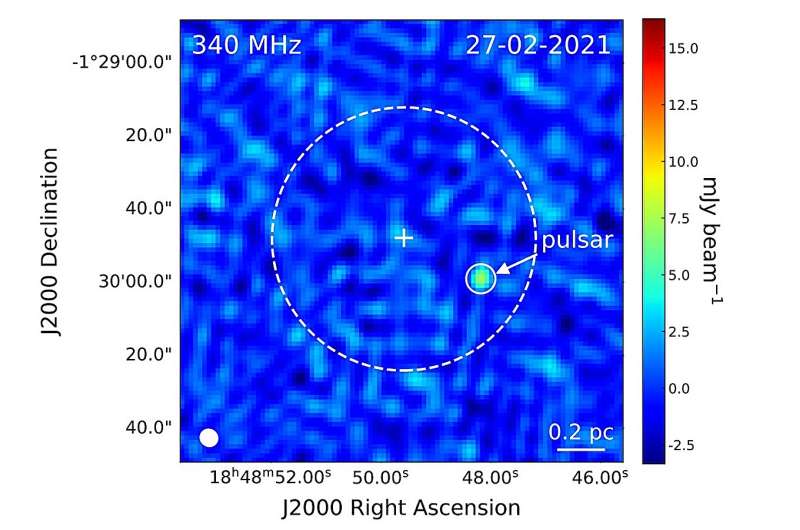December 30, 2023 report
This article has been reviewed according to Science X's editorial process and policies. Editors have highlighted the following attributes while ensuring the content's credibility:
fact-checked
preprint
trusted source
proofread
First pulsar detected in globular cluster GLIMPSE-C01

Using the Karl G. Jansky Very Large Array (VLA), astronomers have discovered a millisecond pulsar in the globular cluster GLIMPSE-C01 as part of the VLA Low-band Ionosphere and Transient Experiment (VLITE). This is the first pulsar ever detected in this cluster. The finding was reported in a paper published December 18 on the pre-print server arXiv.
Pulsars are highly magnetized, rotating neutron stars emitting a beam of electromagnetic radiation from their poles, most commonly in the form of radio waves. The most rapidly rotating pulsars, with rotation periods below 30 milliseconds, are known as millisecond pulsars (MSPs). Astronomers assume that they are formed in binary systems when the initially more massive component turns into a neutron star that is then spun up due to accretion of matter from the secondary star.
Due to their large stellar densities, globular clusters (GCs) are perceived as excellent places for the formation of MSPs. Their stellar densities are so large that many neutron stars can acquire a companion via binary exchange encounters.
That is why a team of astronomers led by Amaris V. McCarver of the Texas Tech University in Lubbock, Texas, decided to conduct a radio imaging search for pulsars in nearly one hundred GCs. For this purpose, they analyzed images from VLITE and from the VLITE Commensal Sky Survey (VCSS).
"In this paper we present a large search for pulsar candidates in globular clusters using low frequency radio continuum images," the researchers wrote.
In total, the team identified 10 sources for the sample of 97 globular clusters. Afterward, they performed a weighted fit using archival and new flux density measurements to determine the spectral index for each source.
The strongest pulsar candidate turned out to be the source in GLIMPSE-C01—a dense and massive intermediate-age GC located about 10,760 light years away from the Earth. The source has an extremely steep spectrum and the analysis of additional radio, X-ray and infrared data confirmed its pulsar nature.
The newfound pulsar, designated GLIMPSE-C01A, has a spin period of 19.78 milliseconds and a dispersion measure of 491.1 pc/cm3. It appears that this pulsar has a higher hard X-ray (2–10 keV) luminosity than most MSPs in globular clusters, while also having a slower spin period. This suggests a high magnetic field—at a level of 1 billion Gauss. The characteristic age of this pulsar is estimated to be 100 million years.
Summing up the results, the researchers note that performing regular timing and establishing an orbital and timing solution for GLIMPSE-C01A is necessary in order to obtain more properties of this pulsar. They added that their discovery underlines the effectiveness of spectral index searches for pulsars.
More information: Amaris V. McCarver et al, A VLITE Search for Millisecond Pulsars in Globular Clusters: Discovery of a Pulsar in GLIMPSE-C01, arXiv (2023). DOI: 10.48550/arxiv.2312.11694
Journal information: arXiv
© 2023 Science X Network




















